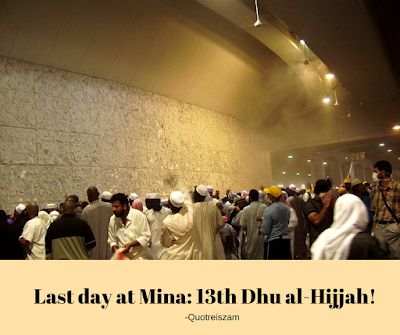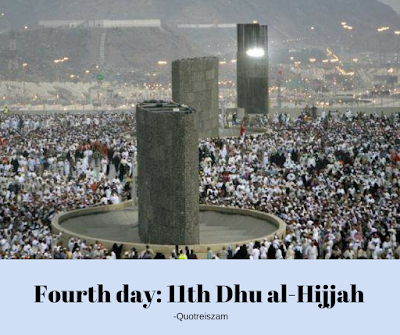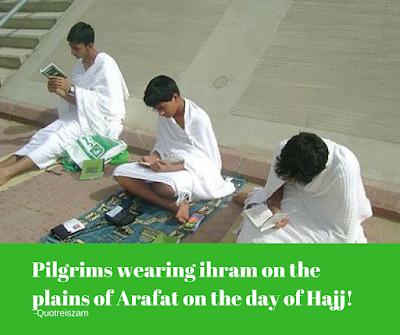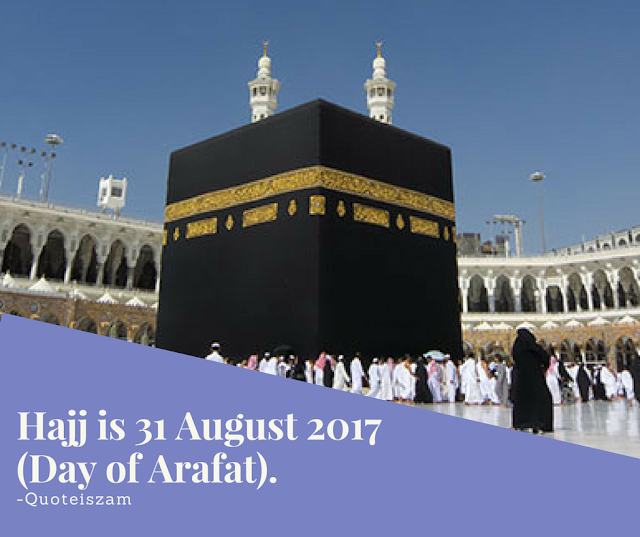Fiqh literature describes in detail the manners of carrying out the rites of Hajj, and pilgrims generally follow handbooks and expert guides to successfully fulfill the requirements of Hajj. In performing the rites of hajj, the pilgrims not only follow the model of Muhammad, but also commemorate the events associated with Abraham.
First day of Hajj: 8th Dhu al-Hijjah
When the pilgrims reach the appropriate Miqat (depending on where they're coming from), they enter into a state of holiness – known as Ihram – that consists of wearing two white seamless cloths for the male, with the one wrapped around the waist reaching below the knee and the other draped over the left shoulder and tied at the right side; wearing ordinary dress for the female that fulfills the Islamic condition of public dress with hands or face uncovered; taking ablution; declaring the intention (niyah) to perform pilgrimage and to refraining from certain activities such as clipping the nails, shaving any part of the body, having sexual relations; using perfumes, damaging plants, killing animals, covering head (for men) or the face and hands (for women); getting married; or carrying weapons. The ihram is meant to show equality of all pilgrims in front of God: there is no difference between the rich and the poor.

The ritual of Tawaf involves walking seven times counterclockwise around the Kaaba.Upon arriving at Al-Masjid Al-Ḥarām (Arabic: الـمَـسـجِـد الـحَـرَام, The Sacred Mosque), pilgrims perform an arrival tawaf either as part of Umrah or as a welcome tawaf. During tawaf, pilgrims also include Hateem – an area at the north side of the Kaaba – inside their path. Each circuit starts with the kissing or touching of the Black Stone (Hajar al- Aswad).If kissing the stone is not possible because of the crowds, they may simply point towards the stone with their hand on each circuit. Eating is not permitted but the drinking of water is allowed, because of the risk of dehydration. Men are encouraged to perform the first three circuits at a hurried pace, known as Ramal, and the following four at a more leisurely pace.
The completion of Tawaf is followed by two Rakaat prayers at the Place of Abraham(Muqam Ibrahim), a site near the Kaaba inside the mosque. However, again because of large crowds during the days of Hajj, they may instead pray anywhere in the mosque. After prayer, pilgrims also drink water from the Zamzam well, which is made available in coolers throughout the Mosque.
Although the circuits around the Kaaba are traditionally done on the ground level, Tawaf is now also performed on the first floor and roof of the mosque because of the large crowds.
Tawaf is followed by sa'ay, running or walking seven times between the hills of Safa and Marwah, located near the Kaaba.Previously in open air, the place is now entirely enclosed by the Sacred Mosque, and can be accessed via air-conditioned tunnels.Pilgrims are advised to walk the circuit, though two green pillars mark a short section of the path where they run. There is also an internal "express lane" for the disabled. After sayee, the male pilgrims shave their heads and women generally clip a portion of their hair, which completes the Umrah.


Tawaf is followed by sa'ay, running or walking seven times between the hills of Safa and Marwah, located near the Kaaba.Previously in open air, the place is now entirely enclosed by the Sacred Mosque, and can be accessed via air-conditioned tunnels.Pilgrims are advised to walk the circuit, though two green pillars mark a short section of the path where they run. There is also an internal "express lane" for the disabled. After sayee, the male pilgrims shave their heads and women generally clip a portion of their hair, which completes the Umrah.
Mina
After the morning prayer on the 8th of Dhu al-Hijjah, the pilgrims proceed to Mina where they spend the whole day and offer noon, afternoon, evening, and nightprayers. The next morning after morning prayer, they leave Mina to go to Arafat.













![Artwork showing locations and rites of Hajj Fiqh literature describes in detail the manners of carrying out the rites of Hajj, and pilgrims generally follow handbooks and expert guides to successfully fulfill the requirements of Hajj.[43] In performing the rites of hajj, the pilgrims not only follow the model of Muhammad, but also commemorate the events associated with Abraham.[4](https://blogger.googleusercontent.com/img/b/R29vZ2xl/AVvXsEjrT9DFG3f4cRTPqhpV4Mv_FO8L1hl-jQ4VYb9JmSk7OgueU7K-hCowFlQ9V9TXU4h10N71Fl_xdbiu1UbvjSXkd4-1osg4Lo7wCzq4gCwVvrQo4WaUELgavVMWmbWK_rVCvLwxB-nx74Q/s400/Make+Du%2527a%252C+Do+your+best%252C+And+leave+the+Rest+To+Allah.+%252813%2529.png)






![Hajj The Hajj (/hædʒ/;[1] Arabic: حَجّ Ḥaǧǧ "pilgrimage") is an annual Islamic pilgrimage to Mecca, the most holy city for Muslims, and a mandatory religious duty for Muslims that must be carried out at least once in their lifetime by all adult Muslims who are physically and financially capable of undertaking the journey, and can support their family during their absence.[2][3][4] It is one of the five pillars of Islam, alongside Shahadah, Salat, Zakat, and Sawm. The Hajj is the largest annual gathering of people in the world.[5][6] The state of being physically and financially capable of performing the Hajj is called istita'ah, and a Muslim who fulfills this condition is called a mustati. The Hajj is a demonstration of the solidarity of the Muslim people, and their submission to God (Allah).[7][8] The word Hajj means "to intend a journey", which connotes both the outward act of a journey and the inward act of intentions.](https://blogger.googleusercontent.com/img/b/R29vZ2xl/AVvXsEgFiczFAQXO84Rn3SGNFYOK7ZX8aulexweh9SvExAyt5mpFirtc3MCRl8J8q4ps1qg3bjPHFwXD_faDatepeIIcE0ssJ1le8UJwvO1SUlUdFqI51bfQx4WOTU5aY17uej7LIUCZx_C0qWM/s640/Make+Du%2527a%252C+Do+your+best%252C+And+leave+the+Rest+To+Allah.+%252811%2529.png)
